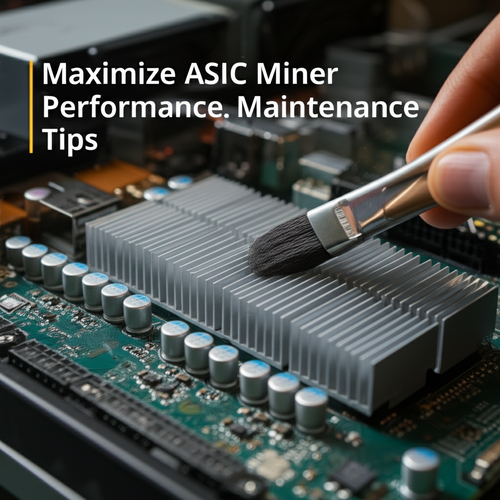Essential ASIC Miner Maintenance Tips for Peak Performance and Longevity
Regular ASIC miner maintenance isn’t just about prolonging hardware life; it’s a direct investment in your mining profitability and operational stability. From meticulous cleaning to strategic firmware updates, and ensuring optimal temperatures to vigilant power supply care, mastering these practices is crucial. Dive into our expert guide to protect your investment, maximize your uptime, and secure a consistent hash rate in the volatile world of cryptocurrency mining.
In the highly competitive world of cryptocurrency mining, an ASIC (Application-Specific Integrated Circuit) miner is your workhorse. Just like any high-performance machine, ASICs require consistent care to operate efficiently, prevent costly downtime, and maintain profitability. Neglecting maintenance can lead to reduced hash rates, increased energy consumption, premature hardware failure, and ultimately, significant financial losses. This comprehensive guide will equip you with the practical knowledge to keep your ASICs running at their best, securing your slice of the digital pie.

The Critical Role of Regular Cleaning for Your ASIC Miner
Dust is the silent killer of electronics, and ASIC miners, with their powerful fans pulling in vast amounts of air, are particularly susceptible. Dust and debris accumulate on heatsinks, fans, and circuit boards, forming an insulating layer that traps heat. This forces the miner to work harder, consume more power, and often leads to thermal throttling, where the device automatically reduces its performance to prevent overheating.
Why a Dust-Free Environment Matters
- Improved Airflow: Clear pathways ensure fans can efficiently dissipate heat.
- Reduced Operating Temperatures: Lower temperatures extend the lifespan of components like capacitors and chips.
- Stable Hash Rate: Prevents thermal throttling, ensuring consistent mining output.
- Energy Efficiency: A cooler miner operates more efficiently, potentially reducing electricity costs.
Essential Cleaning Tools
Before you begin, gather the right tools to avoid damaging sensitive components:
- Compressed Air: For blowing dust out of hard-to-reach areas. Ensure it’s electronics-safe and held upright to prevent propellant discharge.
- Soft-Bristle Brush: An anti-static brush is ideal for gently dislodging stubborn dust.
- Microfiber Cloths/Anti-Static Wipes: For wiping down exterior surfaces and larger components.
- Screwdriver Set: To open the casing if necessary (check manufacturer guidelines for warranty implications).
- Face Mask: To avoid inhaling dust.
Step-by-Step Cleaning Process
- Power Down Safely: Always disconnect the ASIC miner from its power source and allow it to cool down completely before cleaning.
- Initial Exterior Wipe: Use a microfiber cloth to wipe down the outer casing, removing surface dust.
- Fan Cleaning: Gently hold the fan blades to prevent them from spinning too fast (which can damage bearings) and use compressed air to blast dust out. Follow up with a soft brush for any stuck grime.
- Heatsink and Board Cleaning: Direct short bursts of compressed air into the heatsink fins. For circuit boards, use compressed air from a distance to avoid condensation. A soft brush can help with any persistent dust on non-sensitive areas.
- Power Supply Unit (PSU): If accessible and safe, carefully clean the PSU’s fan and vents with compressed air, ensuring it’s also powered off.
- Reassemble and Test: Once clean, reassemble any removed components and power on the miner, monitoring its temperatures for improvement.
Aim for a thorough cleaning every 1-3 months, depending on your environment’s dust levels. In extremely dusty conditions, more frequent checks are advisable.
Navigating Firmware Updates: Security, Efficiency, and Stability
Just like your smartphone or computer, ASIC miners run on firmware – the embedded software that controls the hardware. Manufacturers frequently release updates to enhance performance, fix bugs, improve security, and sometimes even support new mining algorithms.
Benefits of Timely Updates
- Performance Enhancements: Firmware updates can unlock higher hash rates or improve power efficiency.
- Bug Fixes: Address glitches that might cause crashes or instability.
- Security Patches: Protect against vulnerabilities that could be exploited by malicious actors.
- New Features: Some updates introduce new functionalities or improve user interfaces.
Risks and Best Practices
While beneficial, firmware updates carry risks. An interrupted or incorrect update can “brick” your miner, rendering it unusable. Always proceed with caution:
- Official Sources Only: Download firmware exclusively from the manufacturer’s official website. Avoid third-party or unofficial sources, which may contain malware.
- Backup Current Settings: Before updating, save your miner’s current configuration settings.
- Stable Power Supply: Ensure a stable and uninterrupted power supply during the update process. A power surge or outage can corrupt the firmware.
- Read Release Notes: Understand what the update does, any prerequisites, and known issues.
- Patience: Do not interrupt the update process once it has started.
How to Safely Update Your Firmware
The exact steps vary by manufacturer, but a general process involves:
- Download Firmware: Obtain the correct firmware file for your specific ASIC model from the manufacturer’s website.
- Access Miner Interface: Log into your ASIC miner’s web interface using its IP address.
- Navigate to Firmware Section: Find the “System,” “Firmware Update,” or similar section.
- Upload File: Select the downloaded firmware file and initiate the upload/update process.
- Wait for Reboot: The miner will automatically restart after the update. Do not power cycle it manually.
- Verify Update: After reboot, check the firmware version in the interface to confirm the update was successful.
For more detailed instructions, refer to your specific ASIC miner’s user manual or the manufacturer’s support documentation. Bitmain Support is a good example of a manufacturer providing comprehensive guides.

Optimizing Operating Temperatures for Maximum Lifespan
Temperature is perhaps the single most critical factor in an ASIC miner’s lifespan and performance. Consistent high temperatures accelerate chip degradation, reduce efficiency, and can lead to premature failure. Every ASIC has a recommended operating temperature range; exceeding this can significantly impact your mining operation.
Understanding ASIC Temperature Thresholds
Refer to your miner’s specifications for its optimal and maximum operating temperatures. Typically, ASICs perform best when core chip temperatures are between 60°C and 80°C (140°F and 176°F). Sustained temperatures above 85°C should be a red flag.
Effective Cooling Strategies
- Proper Ventilation: Ensure adequate intake of cool air and exhaust of hot air. Avoid recirculating hot air back into the mining area.
- Airflow Management: Arrange miners to create clear air channels. Use fans (exhaust and intake) to maintain positive or negative pressure as appropriate for your setup.
- Ambient Temperature Control: If possible, control the ambient temperature of your mining facility. Air conditioning or evaporative coolers can be effective in hotter climates.
- Dust Control: As discussed, a clean miner is a cooler miner.
- Advanced Cooling (for larger operations): Immersion cooling, where ASICs are submerged in dielectric fluid, offers superior cooling and noise reduction but requires significant initial investment and expertise.
Monitoring and Automation
Modern ASICs typically provide temperature readings in their web interface. Utilize monitoring software or platforms that can track these temperatures and alert you to anomalies. Consider setting up environmental sensors (temperature, humidity) in your mining facility. Some advanced setups use smart outlets or relays that can automatically power down miners if temperatures exceed critical thresholds, preventing damage.
Power Supply Unit (PSU) Care: Fueling Your Mining Operation
The Power Supply Unit (PSU) is the heart of your ASIC miner, converting grid electricity into the stable DC power your chips need. A failing or unstable PSU can cause erratic performance, reduce hash rates, and even damage your entire miner. It’s often an overlooked component in maintenance.
The Importance of a Stable Power Source
- Consistent Performance: A stable PSU delivers consistent voltage and amperage, ensuring your ASIC chips operate optimally without fluctuations.
- Hardware Protection: Protects delicate components from power surges, sags, and dirty electricity.
- Efficiency: A high-quality, well-maintained PSU operates more efficiently, converting more power into usable energy and less into wasted heat.
Best Practices for PSU Longevity
- Right-Sized PSU: Always use a PSU that provides sufficient wattage for your ASIC miner, with a buffer. Overloading a PSU will lead to inefficiency and early failure.
- Clean Power: Connect your ASICs through surge protectors or Uninterruptible Power Supplies (UPS). A UPS can also provide backup power during short outages, preventing abrupt shutdowns.
- Dedicated Circuits: For larger operations, ensure ASICs are on dedicated electrical circuits to prevent overloading household wiring.
- Ventilation: PSUs generate heat. Ensure their intake and exhaust vents are clear and unobstructed.
- Cable Management: Use high-quality power cables that are properly rated for the current draw. Avoid tightly bundling cables in a way that restricts airflow to the PSU or miner.
Recognizing PSU Issues
Be vigilant for signs of a failing PSU:
- Unusual Noises: Grinding, whining, or clicking sounds.
- Intermittent Shutdowns: Miner randomly reboots or turns off.
- Reduced Hash Rate: Inconsistent power delivery can lead to a lower mining output.
- Burning Smell: A strong indicator of serious electrical issues.
- Hot to the Touch: PSUs get warm, but excessive heat indicates a problem.
If you suspect a PSU issue, it’s often safer and more cost-effective to replace it than attempt repairs, especially given the high power demands of ASICs. Learn more about PSU safety from resources like Electrical Safety First.
The Future of ASIC Maintenance: Automation and Predictive Care
As the cryptocurrency mining industry matures, so too will maintenance practices. We’re already seeing trends towards more sophisticated solutions:
- Automated Monitoring Systems: Advanced software platforms that monitor not just hash rate and temperature, but also power consumption, fan speeds, and voltage stability across an entire farm, offering predictive analytics.
- Remote Management Tools: The ability to remotely power cycle, flash firmware, or adjust settings, minimizing the need for on-site presence.
- AI-Driven Diagnostics: Machine learning algorithms that can detect subtle deviations in performance patterns, predicting potential hardware failures before they occur.
- Modular Designs: Manufacturers may increasingly design ASICs with easily replaceable modules (e.g., hash boards, control boards, PSUs) to simplify repairs and reduce downtime.
These innovations aim to make ASIC maintenance less labor-intensive and more data-driven, further optimizing operational efficiency and profitability for miners. Large-scale mining operations are already adopting these practices to manage hundreds or thousands of devices efficiently, showcasing a glimpse into the future for individual miners as well.
Conclusion: Your Path to Sustainable Mining Profitability
Proactive ASIC miner maintenance is not merely a chore; it’s a strategic imperative for any serious cryptocurrency miner. By diligently implementing regular cleaning schedules, staying current with official firmware updates, meticulously managing operating temperatures, and ensuring your Power Supply Units are in peak condition, you are actively safeguarding your investment.
These practices translate directly into enhanced hardware longevity, consistent hash rates, reduced energy consumption, and ultimately, greater mining profitability. As the digital landscape evolves, staying ahead with smart maintenance will solidify your position in the ever-competitive mining ecosystem. Invest in the health of your miners, and they will, in turn, invest in your success.
For more insights into optimizing your crypto mining operations, consider exploring reputable mining forums and communities, such as those found on BitcoinTalk, where experienced miners share valuable tips and troubleshoot common issues.



